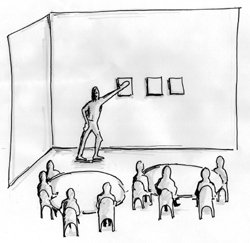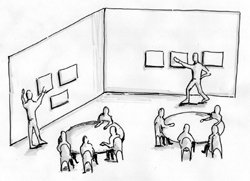Processing the Results
Playing the GameThis game is easily explained, and it is best if the facilitator gets started quickly after the explanation is complete. The first two or three features are usually prioritized quickly and easily. The process starts to slow down as customers typically start to ask more questions about new features being added to the growing list and spend more time debating the location of previously prioritized features. Your goal is to encourage the debate, but to do so you'll need to answer their questions about features. Customers often change priorities by adjusting choices on design continuums. For example, customers may start by wanting the "mid-range" aluminum casing, but find themselves accepting the "low-end" plastic casing when more features are added to the prioritization discussion. Figure 2.20. Organizing Feature CardsThe facilitator puts each card on the wall, one card at a time, based on customer feedback. Customers often want to group features into setsthese three features are A, these are B, and so forth. Do all that you can to avoid this; it makes processing the results more challenging. If you find that you can't guide them against grouping, try making multiple passes over the features. The first pass groups features into must-have, nice-to-have, and don't-care or don't-want features. You should be able to do this fairly quickly. The second pass ranks each of the features contained within these groups. Customers will sometimes ask you to break a single feature into multiple features, combine two or more features into a single feature, or add a new feature. These are generally good things to do because they will provide you with a greater understanding of customer desires and motivations. The facilitator should be the person who makes this decision. Figure 2.21. Facilitating Multiple GroupsYou can have one facilitator manage the interaction for each group of customers. You may find that "clumps" of customers differ significantly in their prioritization of features, to the point where the facilitator cannot guide the larger team to consensus on the ranking of features. If this happens, and as a matter of last resort, split the single group of customers into two or three smaller groups that can be structured to reach agreement. Do this carefully, however, because the value of this technique is in observing how customers discuss feature priorities and design continuums with each other, and splitting customers by definition limits the debate.
Splitting groups of customers during the game is not the same as forming groups of customers at the beginning of the game and running multiple concurrent discussions. Splitting a group should generally be avoided because the power of the game is watching the group struggle with the prioritizations. Running multiple concurrent discussions, with a single facilitator running each discussion, is a way to compare and contrast the relative prioritizations of different customer groups. |
EAN: 2147483647
Pages: 144

